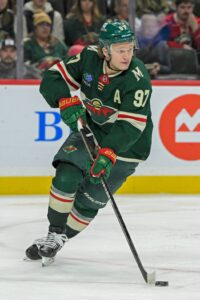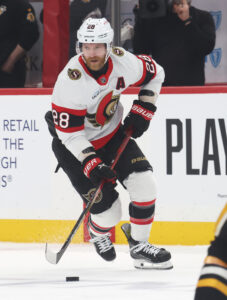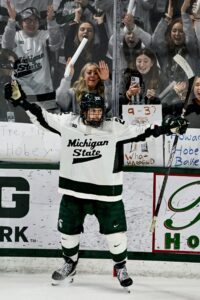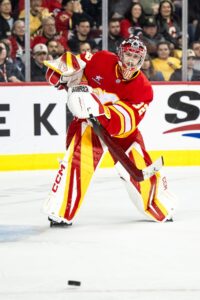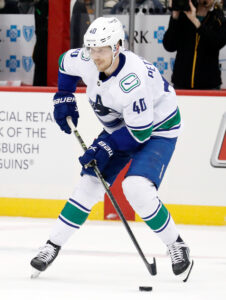The offseason has arrived for all but two teams now with the playoffs nearing an end. Accordingly, it’s time to examine what they will need to accomplish over the coming weeks with free agency fast approaching. Next up is a look at Los Angeles.
Nothing much has changed in Hollywood in recent years. In 2023-24, a streaky regular season dotted by a coaching change ultimately led to a familiar fate – a first-round elimination at the hands of the Oilers. With a full season under head coach Jim Hiller and strong play from offseason and in-season pickups to bolster the forward group, most thought this would finally be the year L.A. escaped a first-round date with Edmonton after three failed tries. Instead, after their best regular-season record in 50 years, they blew a 2-0 series lead and headed for the exits early again. That triggered a big change with new GM Ken Holland succeeding Rob Blake, and he’s got some things to address in his first summer on the job.
Look Ahead To Kempe, Kopitar Expiries
Two years ago, franchise center Anže Kopitar put any retirement speculation to rest early when he signed a two-year, $14MM extension five days after becoming eligible to do so. After an age-37 season in which he saw the lowest average ice time of his career but was still a top-10 defensive forward in the league, he becomes extension-eligible again on July 1. Given his slow decline so far, it’s likely he has more than one season left in him.
While it may make sense for the Kings to wait to see how Kopitar starts next season to gauge where he’s at in his aging curve, it would also be smart to get what will likely be a short-term, team-friendly extension for Kopitar out of the way now. That’s primarily because winger Adrian Kempe’s contract expires following next season and, on the heels of a second straight 70-point season, will shatter his current $5.5MM cap hit on a new deal with Los Angeles.
Of course, the Kings could flip-flop their priorities and enter talks on a long-term deal with Kempe now while kicking Kopitar’s contract down the road until they have cost certainty on the former. Jumping the gun on an older player with less earning potential signing a short-term deal is a smarter financial move than over-committing to Kempe too early, though, especially with the rising cap, meaning extension projections for Kempe fall in the $9MM range (per AFP Analytics).
L.A. has enough cost-effective deals with term, particularly at forward, that they don’t have to stress too much about losing one of the two next summer outside of a surprise retirement decision from Kopitar. Still, knowing both top-liners have contractual business to attend to in the next 12 months will certainly impact how Holland doles out his cap space this summer.
Be Aggressive With Gavrikov
The Kings made an unlikely win-win trade with the Capitals involving Pierre-Luc Dubois and Darcy Kuemper last offseason, opening up around $3MM in cap space for them in the process. That increased flexibility will be pertinent for them this offseason as they try to land more of a game-breaking forward to help put them into the league’s upper echelon of offensive clubs. They have nearly $22MM in projected cap space this summer to do so, but while they can let all of their pending UFAs at forward walk with mostly no ill effect in pursuit of a higher-caliber addition, the same can’t be said on the blue line.
Vladislav Gavrikov was a rock on L.A.’s defense this season, particularly with Drew Doughty missing over half the campaign. Unlike the Kings’ top UFA forward, trade deadline Andrei Kuzmenko, there’s no backup plan involving a similar-caliber UFA pickup if the Kings can’t come to terms with Gavrikov on an extension. From now until July 1, working on numbers with him will presumably be priority No. 1 for Holland.
They simply don’t have another player with his skillset and ceiling in their system, and he provided legitimate top-pairing value this year with 30 points, a +26 rating, and 140 blocks while playing all 82 games and averaging over 23 minutes per night. But with most of the top UFA defensemen signing extensions and taking themselves off the market early, he’s the top left-shot option available. That could drive up his extension price, although the Kings have the benefit of being able to offer him an eighth year on his contract to award him the same (or higher) total compensation while keeping his cap hit down.
AFP Analytics’ open market projection for Gavrikov is a seven-year deal at $7.6MM per season for a total value of $53.25MM. The Kings could offer Gavrikov $55MM total on an eight-year deal while keeping his cap hit at a much lower $6.875MM per season, though. That’s a significant difference as they try to keep their options open for going big-game hunting at forward.
Decide Clarke’s Future
Gavrikov isn’t the only name potentially in flux on L.A.’s blue line. Righty Brandt Clarke, the 2021 eighth-overall pick, is slated to be a pending RFA coming off his first full-time NHL season, but still found himself as trade fodder at the deadline.
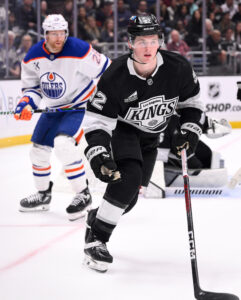 That’s despite the 21-year-old serving as the offensive cornerstone of the Kings’ defense in Doughty’s absence. He put together a 5-28–33 scoring line in 78 games and managed a +13 rating to boot, but never seemed to earn the organization (or Hiller’s) full trust. He averaged decidedly bottom-pairing minutes at just 16:17 per game.
That’s despite the 21-year-old serving as the offensive cornerstone of the Kings’ defense in Doughty’s absence. He put together a 5-28–33 scoring line in 78 games and managed a +13 rating to boot, but never seemed to earn the organization (or Hiller’s) full trust. He averaged decidedly bottom-pairing minutes at just 16:17 per game.
With the Kings’ questionable usage of their top U-22 player, the feeling might be mutual if Clarke doesn’t feel Los Angeles is the right environment for him to maximize the rest of his development years. He would have immense trade value this summer, not just for his potential impact in a top-four role for a club next season, but because he’d be doing so on a six-figure cap hit in the final year of his ELC.
His trade value would be enhanced further by a weak UFA market, even more so among right-shot defenders than lefties. He would presumably be the No. 2 target at the position if he were on the open market this summer behind Aaron Ekblad, taking both his 2024-25 performance and his still-untapped ceiling into consideration.
If Holland strikes out on the upper echelon of UFA forward talents like Nikolaj Ehlers and Mitch Marner, expect him to leverage Clarke again as he pursues a higher-ceiling winger, potentially Buffalo’s JJ Peterka. In any event, it’s highly unlikely the Kings commit resources to a Clarke extension this summer, particularly with some aforementioned bigger fish to fry.
Sign Laferriere Quickly
Moving away from UFA talk, the Kings do have one notable RFA to deal with this summer. That would be winger Alex Laferriere, whose negotiations could become a headache if the Kings get a Gavrikov extension done and blow the rest of their cap space on a big forward pickup.
The 23-year-old is a highly intriguing top-six winger with a physical edge, finishing third on the team with 124 hits this season. He also logged a +22 rating, put together a 19-23–42 scoring line in 77 games, and averaged 16:32 per game – a legitimate needle-moving depth piece the Kings would likely prefer to retain given his age.
Getting cost certainty on Laferriere, even if it’s a bridge deal to keep his cap hit down, is important for Holland to know if he needs to make any cap-clearing moves to maintain flexibility for Gavrikov and their clearly desired forward pickup. Locking him in could make an older player with a similar price point and offensive ceiling, such as winger Trevor Moore, an expendable asset if L.A. needs to open up some roster space or spending money.
Image courtesy of Robert Hanashiro-Imagn Images.
